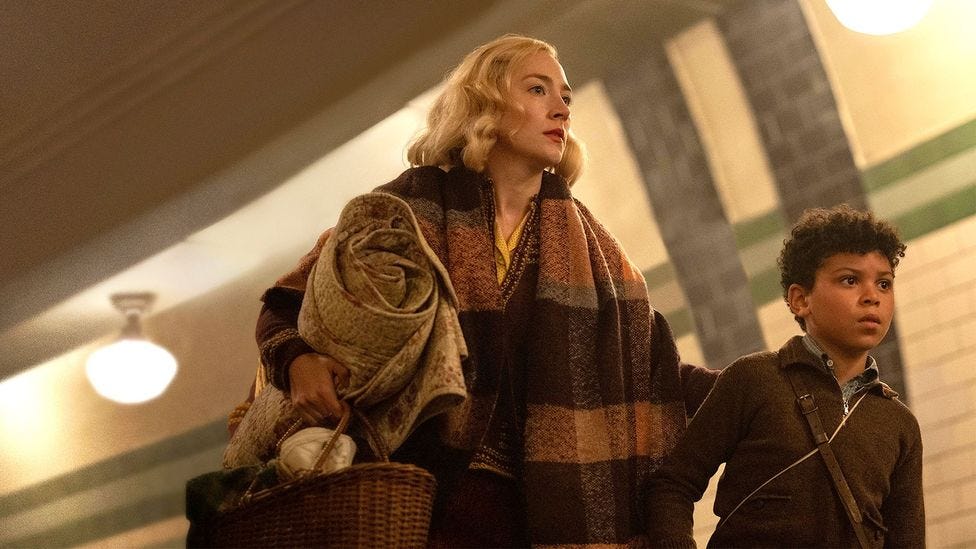Movie: Blitz 2024
A look at the real events depicted in the new Steve McQueen film
I can strongly recommend watching Steve McQueen’s Blitz over the holiday period. I watched with some research in mind for World War Two Gangs, my second gang-related writing project. I was not disappointed. No spoilers below, this is not a review, and I hope the additional context will add to your enjoyment of an entertaining film.
Protests to open tube stations during air raids
One of the early scenes sees Rita and her nine year-old son George running for cover during an air raid. They reach nearby Stepney Green tube station only to find the gates locked shut for the night. A crowd forms, and starts chanting. After some anger, a persistent policeman persuades an official, presumably an underground worker, to unlock the gates and allow people to protect themselves. The argument is based on it being ‘against the law’ for the public to shelter in the London Underground. Later in the film, an organised protest sees some of Rita’s friends at the munitions factory broadcast their views on the radio. By the end of the film, the tube network is routinely being used as an air raid shelter with hot drinks, blankets, and sometimes even beds and live entertainment such as a Punch & Judy show.
I am not sure whether the radio broadcast has any real-life parallel (please write in the comments if you know anything about this) but the struggle for air raid protection was a big national news story and the tube filling up with members of the public taking cover during an air raid became a symbol of the Blitz.
The flooding of London Bridge tube station
It might seem as though the tube tunnels would be bomb proof but many are not as deep underground as others, and a scary scene towards the end of the film sees a bomb pierce the tunnels at London Bridge, leading to dramatic flooding. The terror of a tube tunnel filling with water can easily be imagined, and as far as I know London Bridge did not suffer this fate. However there is a famous Blitz event which did see Balham tube station flood, on 14th October 1940. There are photos also of a bus falling through the roadway and into the tube tunnel. Around 65 people were killed outright and another 70 injured. The precise numbers vary from report to report. And in this real episode, the bomb hit at 8pm while trains were still running.
The bombing of the Café de Paris
This is the most shocking scene in the movie, and it helps us to better understand the night of 8th March 1941. The date is moved to work within the timeline of the film, but the reference is very clear. The Café de Paris near Leicester Square was constructed in an unusually solid way, and was widely claimed to be bomb proof by its owner. Unfortunately this was far from the case, and a direct hit during a performance led to at least 34 deaths and 80 injured. One of the fatalities was the over-confident owner, Martinus Poulsen.
These facts would be shocking enough but in the aftermath, as the police and other emergency services treat the wounded and remove the bodies, we see a gang working in the shadows, looting jewellery including earrings from the dead. A pair of pliers is seen, presumably for removing fingers to access valuable rings. In a gruesome twist the we can only hope is an invention for the film, the dead are used like puppets and made to hold cocktail glasses as if drinking from them.
Reflections on Blitz Crime
Everyone knows something about the London Blitz. We most often hear about it as a time of keeping calm and carrying on. We hear how neighbours and colleagues pulled together, how everyone got along and made the best of it. More recent books have given the lie to this rosy nostalgic representation. No doubt that sort of thing happened, but as only one side of a very nuanced story. The looting of the warm corpses at the Café de Paris vividly calls to mind a darker side to the Blitz. This is a side of opportunism, cynicism and selfishness. It’s not a part of the story that anyone would be proud of, and it is easy to see why it was suppressed either deliberately or through omission, but my early research on crime, and especially gang crime, suggests that such behaviour was comparatively widespread.
Please note that I have now divided Crime Guy into sections. You are receiving this in the section “Historical Crime”. You can subscribe separately to the sections that interest you, or all sections at once.



I like you Paul, but we must disagree here, It is a dreadful film.